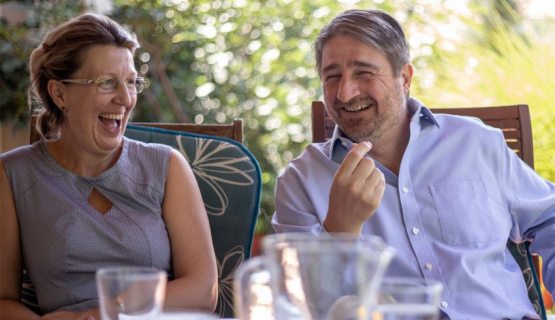Dr. Dóra Vesztergom: “The ovaries cannot be botoxed”
Warning! The following interview contains phrases that are likely to disturb the peace, with intent. We aim to sound the alarm bell and make young people aged 30-35 aware that if they want to have children, it is time to put everything else on the back burner for a while. It is possible to build a career, travel, buy a good car or a house with a garden after 40, but the fertility period is finite, and the chances of having children fall sharply after the age of 37. Dr. Dóra Vesztergom, a reproductive endocrinologist and infertility specialist, works every day to help couples who " ran out of time" to have children.

Why did you choose this relatively narrow field of gynaecology?
“Prior to the birth of my first child I, too, suffered from endocrinological difficulties. As a gynaecologist, I met several patients who either had endometriosis or could not conceive due to other hormonal problems, which is why I began to immerse myself more deeply in the subject. Then when I experienced what fantastic results could be achieved with the precise observation of hormones, the biological cycle and follicular development, one might say I was ‘sucked into’ the field.”
Where we are now, the Semmelweis University Assisted Reproduction Centre, is a brand-new section. Who can come here for help?
“This clinic was founded so that as many wanted child as possible could be born, and as a place where men and women struggling with infertility could find help. The complex set of examinations is state financed; we use the very latest 3D technology to examine the anatomy of the uterus, we check the hormonal functioning of all the key organs, if necessary the immune functions, the coagulation system, indeed even genetic factors. We apply the most up-to-date methods when examining the male partner, too, and there is the chance to have an immediate consultation with our andrologist. We recommend free psychology screening for all our patients, indeed, we conduct any necessary treatment here. Our dietician is on hand for consultations with anybody who needs her. These somewhat costly procedures, insemination treatment and IVF therapy are fully covered by the state.”
Not long ago you gave a TEDx talk which revealed some astonishing data: over the past 10 years, the number of couples turning to fertility clinics for help has tripled. What do you think is the reason for this drastic increase?
“The single biggest problem is pushing back the time couples start thinking about having a family. The number follicles in the ovaries is genetically predetermined at birth and as one ages, their number constantly declines. Parallel with this we see a decline in the quality of ovum, which increases the risk of abnormalities and miscarriage. The fertility of men has also deteriorated a lot in recent times, and less is said about this.
“It is a common myth that infertility is basically a women’s problem although the statistics show that childlessness can be traced back virtually 50:50 to men’s and women’s bodies.”
How do men take this?
“Very hard, frequently worse than women. It can even be difficult to persuade some to take a sperm examination. They experience it as a personal failure, they feel that their masculinity is in question when they have been unable to fertilize their partner. In a normal case, for women 40 is the ‘magic’ number, and for men after 50 is when the fertility of sperm begins to decline at a faster rate.”
What else affects fertility?
“Lifestyle. Without doubt, a sedentary lifestyle and obesity reduce the chances of pregnancy. Instead of or alongside dieting, I would recommend everyone wanting to have a child to participate in active sport for one hour three times a week because this has been proven to have a beneficial effect on fertility. Of course, it’s not good either if someone is too thin, just as if they are too fat because for women in these cases menstruation may be missed and thus there is no follicular maturation. From the point of view of sperm, it is better if men swap overly tight trousers for a looser fit, and around the time of planning a family it is well worth giving up regular visits to the sauna hot baths.
“Smoking is the principal enemy that ruins the quality of sperm and ovum.
“On top of this, women who regularly smoke find they enter menopause two to three years earlier and this harmful addiction clearly damages the chances of a successful outcome to IVF. The psychological factor similarly is of massive significance, that is, what sort of stressed state couples wanting children are in.”
The ideal situation is when a woman is able to give birth to all the children she and her partner want when she is in her twenties, but latest by the age of 35. However, these days very many people only discover ‘Mr or Mrs right’ when they are over 35. What advice would you have for them?
“If it is just a question of whether or not to ‘live life’ together, to travel for another three years before having a baby, I would suggest they decide to have a child as soon as possible.”
Isn’t it possible to ‘touch up’ our age somewhat with exercise, proper nutrition and regular doses of vitamins? The ads tell us that 40 is the new 30, and the fact is that as a consequence of a planned lifestyle transformation many women are more attractive and fitter than they were at 25… How deceiving are looks?
“The ovaries cannot be botoxed! This pithy statement did not come from me but from a British doctor, but I am in complete agreement with her.
“It doesn’t matter how externally youthful a person appears, the quantity of follicles in the ovaries gives a true picture of her age.
“There is plenty of research going on in this field but as at today, there is absolutely no method or cure that can rejuvenate the ova.”
On average, how long after consistent failure do couples turn to the fertility clinic for help, in fact, how long is it worth waiting for successful conception?
“One year for women aged under 35, while those aged over 35 should approach a specialist after six months of unsuccessful attempts at conceiving. There can be many reasons why a baby does not come, and it is worth finding what the problem is as soon as possible. Anyone who has had, for example, several bouts of acute pelvic inflammation, abdominal surgery or endometriosis may find these cause serious adhesions that can obstruct the free passage of the fallopian tubes and thus conception itself.”
Aren’t you concerned that the statistics mentioned in your lecture might put off couples approaching their forties who are exactly thinking about having children?
“This placed me in a serious dilemma before the lecture. Only after lengthy deliberation did I convince myself.
“Obviously, these data are shocking, but does this mean we shouldn’t talk about them? I believe that we, the experts, must draw the attention of young people to the fact that if they want to have children, around the age of 30 they have to start working on this and deal with family planning in a far more organized manner.
“Thank God, many 40-year-old women become pregnant spontaneously and give birth to perfectly healthy children. The fundamental purpose of my lecture was not to frighten but far more to raise awareness that, unfortunately, there are similarly very many for whom this does not go so smoothly. It is our experience that among those waiting to be blessed with children there is a serious level of misinformation in this area and some simply run out of time. For example, there is not such general awareness in the public consciousness that female fertility declines drastically after the age of 37. At this age, even a year’s delay can have major significance, so it is important that young people are made aware of this. Awareness in this area should be the task of society as a whole.”
Infertility is such a blunt, shocking expression. In a medical sense, who and from when can someone be considered infertile?
“I don’t like the word infertility. The Anglo-Saxon terminology is infertility but more recently we prefer to use the expression subfertility (reduced fertility) because many couples find they can conceive after undergoing fertility therapy. By definition, the watershed is the previously mentioned age-dependent six months or one year of unsuccessful attempts, after which infertility can arise. The professional protocol is that social security will not fund IVF treatment for those aged over 45 because on average only a single child is born for every 10 treatments. Even in the years prior to this – despite social security financing five attempts – it may happen that a woman’s hormonal state and follicle stock is such that after one or two stimulations we don’t see any sense in conducting any further IVF treatments and then, however painful it may be, we have to inform the patients of this.”
Are there miracles? Have you come across any cases that you cannot explain as a doctor?
“Yes, several.
“As I have already said, much depends on the psychological factor.
“Not long ago I read that around 15% of women successfully conceive spontaneously after unsuccessful IVF treatment. But I could also mention that at age 43 there is, let’s say, a 3-4% chance of becoming pregnant after in vitro fertilization, and there are cases where this happens. That is why I don’t like putting off couples approaching their forties with the depressing statistics. However, among the younger age groups I am happy to tell them, in their own interest, how fertility indicators change with advancing age, or to put it another way, I sound the warning bell.”
In Hungary, there are about 150,000 couples who cannot have children through natural channels. This is why from 1 February 2020, the government has made all drugs and interventions used in fertility treatment free of charge, and from July the preliminary examinations also become totally state financed. The chances are further enhanced with the cancellation of performance volume limits, that is, waiting lists are abolished. Fertility expert Dr. Dóra Vesztergom reckons that making the costly interventions free of charge is of significant assistance yet it is important to draw attention to the fact that in many instances, infertility is purely down to late planning for a family. The awareness of young people in this area should be increased with social cohesion.





